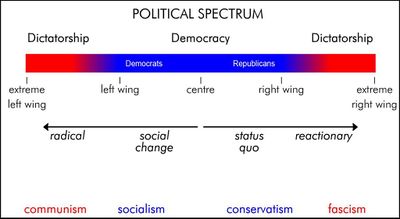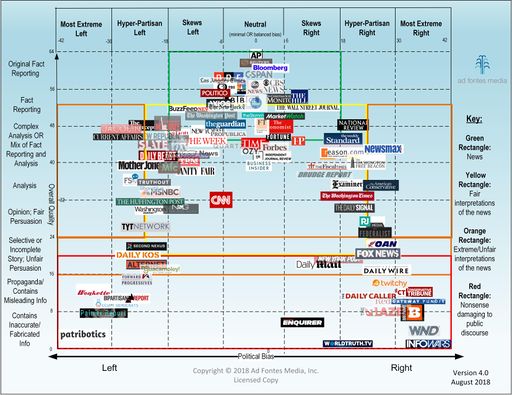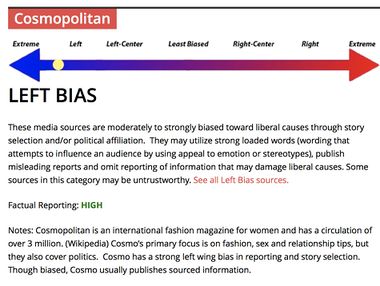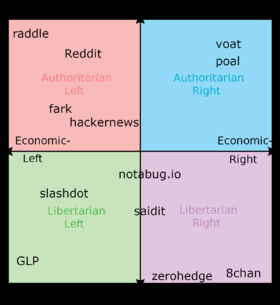Difference between revisions of "Political spectrum"
(Political compass) |
m (revert) |
||
| (5 intermediate revisions by 2 users not shown) | |||
| Line 4: | Line 4: | ||
|image_width=400px | |image_width=400px | ||
|constitutes=Polarising perspective | |constitutes=Polarising perspective | ||
| + | |description=A metaphorical mapping from all conceivable political systems onto a single dimension. As extreme simplifications go, it was remarkably effective in the 20th and early 21st centuries at polarising political debate and limiting options. | ||
}} | }} | ||
| − | The '''political spectrum''' is a model which attempts to simplify the relationship between political [[ideologies]]. It [[polarises]] people and | + | The '''political spectrum''' is a model which attempts to simplify the relationship between political [[ideologies]]. It [[polarises]] people and [[dumbs down]] political debate. Its traditional manifestation has only a single dimension, although it may have 2 dimensions, in which case it is called a "[[#Political compass|political compass]]". |
==Conventional usage== | ==Conventional usage== | ||
| + | [[image:Media Bias Fact Check cosmopolitan.jpg|left|380px|thumbnail|The "[[fact checking]]" website [[Media Bias/Fact Check]] makes extensive use of the political spectrum.]] | ||
[[image:Polarising political spectrum.jpg|512px|thumbnail|A modern graphic from {{ccm}} which ties in the "[[fake news]]" and anti-"[[extremism]]" scares. It shows corporate media as middle of the road (or "mainstream"). The Y-dimension is not actually used in this graphic, leaving it a on-dimensional, traditional spectrum. The implied subtext is that the more a group diverges from this opinion, the more inaccurate and mendacious its reporting.]] | [[image:Polarising political spectrum.jpg|512px|thumbnail|A modern graphic from {{ccm}} which ties in the "[[fake news]]" and anti-"[[extremism]]" scares. It shows corporate media as middle of the road (or "mainstream"). The Y-dimension is not actually used in this graphic, leaving it a on-dimensional, traditional spectrum. The implied subtext is that the more a group diverges from this opinion, the more inaccurate and mendacious its reporting.]] | ||
| Line 31: | Line 33: | ||
==Political compass== | ==Political compass== | ||
| − | [[image:political compass.png|A 2019 political compass including websites|left|280px]] | + | [[image:political compass.png|A 2019 political compass including websites|left|280px|thumbnail]] |
A popular refinement of the one-dimensional concept of the political spectrum is to add a second dimension corresponding to the relationship between the individual to the state, resulting in the "political compass". | A popular refinement of the one-dimensional concept of the political spectrum is to add a second dimension corresponding to the relationship between the individual to the state, resulting in the "political compass". | ||
Libertarian [[David Nolan]] introduced the Nolan Chart, which uses an X-axis defined as “Economic Freedom” and a Y-axis as “Personal Freedom”.<ref name=www2017>http://whowhatwhy.org/2017/03/26/moving-past-left-right-divide/</ref> | Libertarian [[David Nolan]] introduced the Nolan Chart, which uses an X-axis defined as “Economic Freedom” and a Y-axis as “Personal Freedom”.<ref name=www2017>http://whowhatwhy.org/2017/03/26/moving-past-left-right-divide/</ref> | ||
| Line 38: | Line 40: | ||
Apart from rejecting such [[polarising perspectives]], Wikispooks generally rejects the claim that modern [[nation states]] are [[democratic]] in that they faithfully represent the will of the people, so it is recommended not to use the "[[left]]"/"[[right]]" labels here. | Apart from rejecting such [[polarising perspectives]], Wikispooks generally rejects the claim that modern [[nation states]] are [[democratic]] in that they faithfully represent the will of the people, so it is recommended not to use the "[[left]]"/"[[right]]" labels here. | ||
{{SMWDocs}} | {{SMWDocs}} | ||
| + | |||
| + | |||
==References== | ==References== | ||
{{reflist}} | {{reflist}} | ||
Latest revision as of 16:47, 1 March 2021
(Polarising perspective) | |
|---|---|
 | |
| A metaphorical mapping from all conceivable political systems onto a single dimension. As extreme simplifications go, it was remarkably effective in the 20th and early 21st centuries at polarising political debate and limiting options. |
The political spectrum is a model which attempts to simplify the relationship between political ideologies. It polarises people and dumbs down political debate. Its traditional manifestation has only a single dimension, although it may have 2 dimensions, in which case it is called a "political compass".
Contents
Conventional usage

Although more complex, (multi-dimensional) usages are possible, the traditional representation is to classify political ideologies on a single dimension, from 'left' (communist, socialist) to right (conservative, fascist).
Concerns
The 'political spectrum' concept although popular with commercially-controlled media is is understood to be a polarising oversimplification; although left and right are opposites in a physical sense, they are clearly not in a political sense.
“The right is cast as wanting little to no government, while the left advocates for big government. But upon closer examination, this doesn’t hold up: both the left and right seem to want big government; the question is, where?
The right traditionally wants a large military and ever increasing defense budgets, while the left favors domestic entitlement programs like Social Security and Medicare.
Those not wishing to get caught in this perilous conflict don’t really have a spot on the traditional political spectrum because it only offers a binary choice.”
Jimmy Falls (26 March 2017) [1]
Polarisation
- Full article: Polarising perspective
- Full article: Polarising perspective
The nature of the political spectrum invites its usesrs, unless they place themselves in the exact center, to label themselves "left" or "right". Either group of people is purported - according to the spectrum metaphor - to have a lot in common. This polarising perspective has long been exploited as a divide and conquer tactic of social control.
Political compass
A popular refinement of the one-dimensional concept of the political spectrum is to add a second dimension corresponding to the relationship between the individual to the state, resulting in the "political compass". Libertarian David Nolan introduced the Nolan Chart, which uses an X-axis defined as “Economic Freedom” and a Y-axis as “Personal Freedom”.[2]
Deep political perspective
Apart from rejecting such polarising perspectives, Wikispooks generally rejects the claim that modern nation states are democratic in that they faithfully represent the will of the people, so it is recommended not to use the "left"/"right" labels here.
Examples
| Page name | Description |
|---|---|
| "Extreme left" | One pole of the highly suspect "political spectrum". A tool in the divide and conquer strategy of party politics. |
| "Extreme right" | One pole of the highly suspect "political spectrum". A tool in the divide and conquer strategy of party politics. |
Related Quotations
| Page | Quote | Author | Date |
|---|---|---|---|
| Jean Bricmont | “We often hear that the left-right opposition is outdated or no longer makes sense. But the problem is worse: on many issues, the left-right opposition has reversed itself, the left adopting positions that were those of the right or the far-right in the past and part of the right doing the opposite. Let's start with the question of peace and war. Since the wars have become "humanitarian", it is the left, including the bulk of the "radical" left, which supports them. When a perfectly orchestrated coup takes place in Ukraine, we celebrate the victory of democracy. In Syria, until recently, support, at least verbal, for the "rebels" was not debated in the left. During the bombings on Libya, Mélenchon argued that it was necessary to prevent the "tyrant" Gaddafi from killing the revolution. We realized a little late that the opponents of the said tyrant, like the bulk of the rebels in Syria, were also our opponents, that is to say fanatical Islamists. But the classical left, at least in its radical part, but sometimes also in a certain part of social democracy, was opposed to imperial policies, interference and American hegemony, especially during the Vietnam War. Today, the simple fact of defending the principle of national sovereignty passes for being far-right.” | Jean Bricmont | January 2017 |
| George Carlin | “Now, to balance the scale, I'd like to talk about some things that bring us together, things that point out our similarities instead of our differences. 'Cause that's all you ever hear about in this country. It's our differences. That's all the media and the politicians are ever talking about—the things that separate us, things that make us different from one another. That's the way the ruling class operates in any society. They try to divide the rest of the people. They keep the lower and the middle classes fighting with each other so that they, the rich, can run off with all the fucking money! Fairly simple thing. Happens to work. You know? Anything different—that's what they're gonna talk about—race, religion, ethnic and national background, jobs, income, education, social status, sexuality, anything they can do to keep us fighting with each other, so that they can keep going to the bank! You know how I define the economic and social classes in this country? The upper class keeps all of the money, pays none of the taxes. The middle class pays all of the taxes, does all of the work. The poor are there just to scare the shit out of the middle class. Keep 'em showing up at those jobs.” | George Carlin | |
| Corporate media/Logic | “Now, to balance the scale, I'd like to talk about some things that bring us together, things that point out our similarities instead of our differences. 'Cause that's all you ever hear about in this country. It's our differences. That's all the media and the politicians are ever talking about—the things that separate us, things that make us different from one another. That's the way the ruling class operates in any society. They try to divide the rest of the people. They keep the lower and the middle classes fighting with each other so that they, the rich, can run off with all the fucking money! Fairly simple thing. Happens to work. You know? Anything different—that's what they're gonna talk about—race, religion, ethnic and national background, jobs, income, education, social status, sexuality, anything they can do to keep us fighting with each other, so that they can keep going to the bank! You know how I define the economic and social classes in this country? The upper class keeps all of the money, pays none of the taxes. The middle class pays all of the taxes, does all of the work. The poor are there just to scare the shit out of the middle class. Keep 'em showing up at those jobs.” | George Carlin | |
| Dan Dicks | “The internet we have today is not going to be around very much longer. They need to control the narrative...
They are starting to clamp down, not on just conservative voices. It's not about those on the right, it's not about people on the left, it's about anybody who goes against the status quo.” | Dan Dicks | June 2019 |
| Ulrike Guérot | “[Interior Minister] Nancy Faeser when she is interviewed then of course says that the Democracy Promotion Law is there to weaken the anti-democrats and to strengthen the friends of democracy, although exactly the opposite is done. It is called the extremist centre, so the centre itself is becoming extremist, ideologizes itself and does not realize that it will thereby marginalize itself and damage democracy. The extremist center does not realize that has made itself extremist.” | Ulrike Guérot | June 2024 |
| Hannes Hofbauer | “The current right is green. It combines all the necessary ingredients for this: enthusiasm for war, cancel culture, geopolitical and cultural missionary zeal, affinity for the authoritarian state and a lot of created enemy images. The term fascism is inappropriate for them, because it contained the promise of a common people's body with corresponding isolation from the outside, coupled with an emphasis on racial superiority. The opposite is the case with the new right. It itself says what it stands for: cosmopolitanism and the emphasis on the superiority of its values form a toxic mixture with which internal repression and external expansion are justified.” | Hannes Hofbauer | April 2023 |
| Monopoly | “[B]oth the extreme right and the extreme left of the conventional political spectrum are absolutely collectivist. The national socialist (for example, the fascist) and the international socialist (for example, the Communist) both recommend totalitarian politico-economic systems based on naked, unfettered political power and individual coercion. Both systems require monopoly control of society. While monopoly control of industries was once the objective of J. P. Morgan and J. D. Rockefeller, by the late nineteenth century the inner sanctums of Wall Street understood that the most efficient way to gain an unchallenged monopoly was to "go political" and make society go to work for the monopolists — under the name of the public good and the public interest. This strategy was detailed in 1906 by Frederick C. Howe in his Confessions of a Monopolist.” | Antony Sutton |
Related Document
| Title | Type | Publication date | Author(s) | Description |
|---|---|---|---|---|
| Document:The tyranny of the political spectrum | article | 5 March 2017 | Peter | Details of an exchange in the comments section of an article on the World Socialist Web Site between the author and a regular WSWS commentator which was quickly removed by the site operators. It illustrates the blinkered censorious nature of activists committed to both 'Left' and 'Right' - in this case the 'Left'. |

